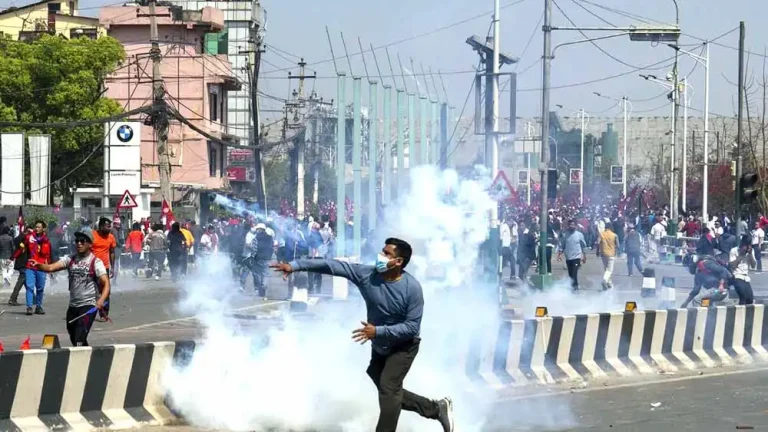Tensions are rising in Nepal’s capital as monarchist supporters, led by the Rastriya Prajatantra Party (RPP), continue their protests demanding the release of detained leaders Rabindra Mishra and Dhawal Shamsher Rana. The arrests, following a deadly clash on March 28 near Tinkune, have sparked renewed calls for the reinstatement of the monarchy and the declaration of Nepal as a Hindu state. Demonstrators are also calling for an investigation into the violent incident that left two people dead and many injured.
RPP Rallies Gain Momentum Across Kathmandu
Monarchist demonstrations have spread across key areas of Kathmandu. On Friday, RPP supporters marched from the replica Dharahara tower to Shanti Batika. Many waved national flags and chanted slogans calling for the release of Mishra and Rana.
Rajesh Bhattarai, one of the protesters, said, “We want justice. The leaders were arrested without proper reason. Our demands are clear — release them and recognize Nepal as a Hindu nation.”
The RPP claims the federal democratic system introduced after 2006 has failed. They now advocate for a return to a constitutional monarchy, alongside a multiparty democratic setup.
Charges and Clashes: What Happened on March 28?
The confrontation on March 28 occurred near Tinkune airport in Kathmandu during an RPP-led march. According to the police, the protest turned violent, resulting in two deaths and several injuries. Rabindra Mishra and Dhawal Shamsher Rana were later arrested and charged with inciting violence.
Another figure linked to the incident, Durga Prasai, remains unaccounted for as of this writing. The RPP has rejected the charges, labeling them politically motivated.
The Ministry of Home Affairs has yet to comment in detail. However, a senior official confirmed an internal review of the incident is underway.
Monarchists Demand Hindu State and Constitutional Changes
Beyond the immediate release of their leaders, RPP supporters have revived their long-standing demand: reinstating Nepal as a Hindu nation. The country’s secular status, established in the 2015 constitution, remains a point of contention for royalist groups.
Pashupati Shamsher JB Rana, former RPP chairman, emphasized the need for a ceremonial monarchy, saying, “Countries like the United Kingdom have a system that blends monarchy with democracy. Nepal can do the same.”
The RPP, formed in the early 1990s, has long promoted monarchical values. Though its parliamentary strength has varied, it remains a vocal political force pushing for a Hindu kingdom under a symbolic king.
Background: End of Nepal’s Monarchy
Nepal officially became a republic in 2008 after the abolition of its centuries-old monarchy. The move followed years of civil unrest and a popular uprising known as ‘People’s Movement II’ in 2006. The campaign brought an end to King Gyanendra’s rule and paved the way for a federal democratic republic.
Despite this political shift, pro-monarchy sentiments have not disappeared. A section of the population remains nostalgic for the monarchy, especially amid rising concerns about governance, corruption, and political instability.
Public Safety and Political Implications
Authorities have increased security around major protest sites to prevent further clashes. Human rights organizations are calling for transparency in handling the arrests and ensuring peaceful protest rights are respected.
Political analysts say the protests reflect a deeper dissatisfaction among a section of citizens. “It’s not just about monarchy or religion,” said Dr. Sushil Thapa, a political analyst. “It’s about trust — or the lack of it — in the current system.”
The RPP has vowed to continue its demonstrations until their leaders are released. More rallies are expected in the coming days, and political tensions are likely to remain high.
As the situation unfolds, questions about Nepal’s political future — monarchy, secularism, and federalism — are once again at the center of national debate.


